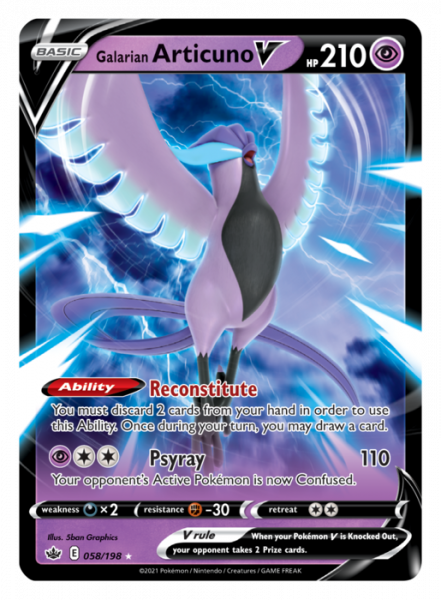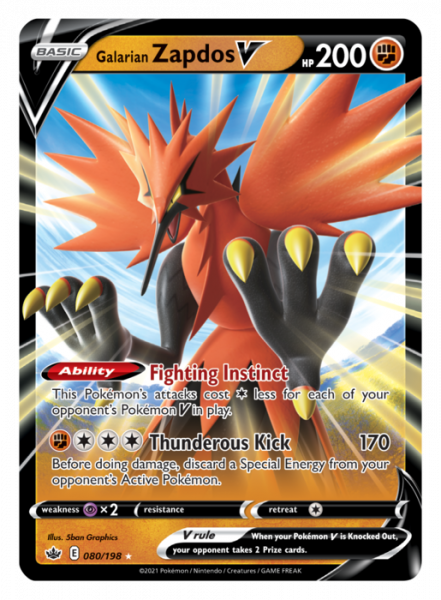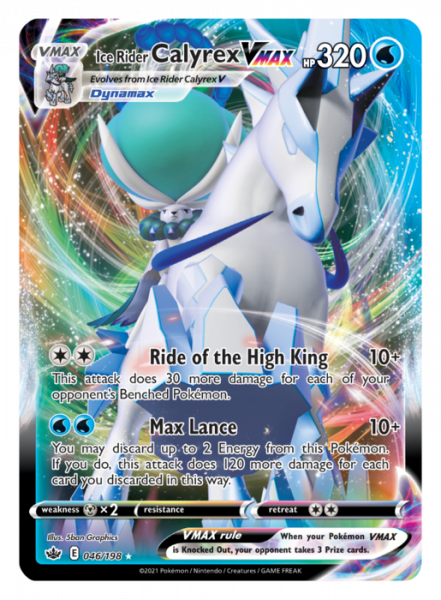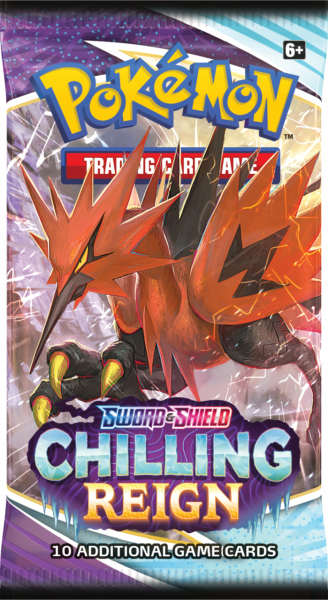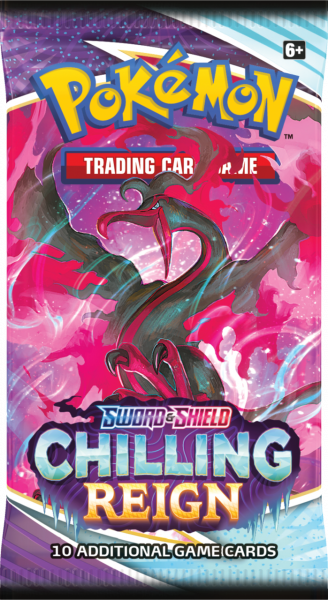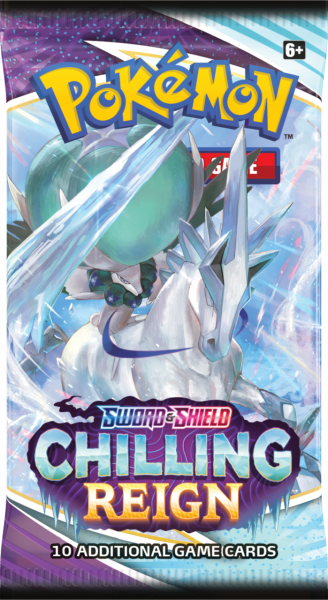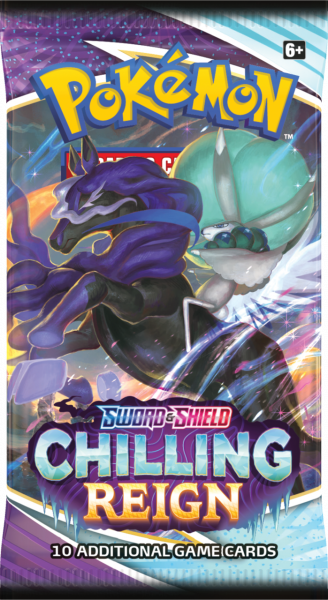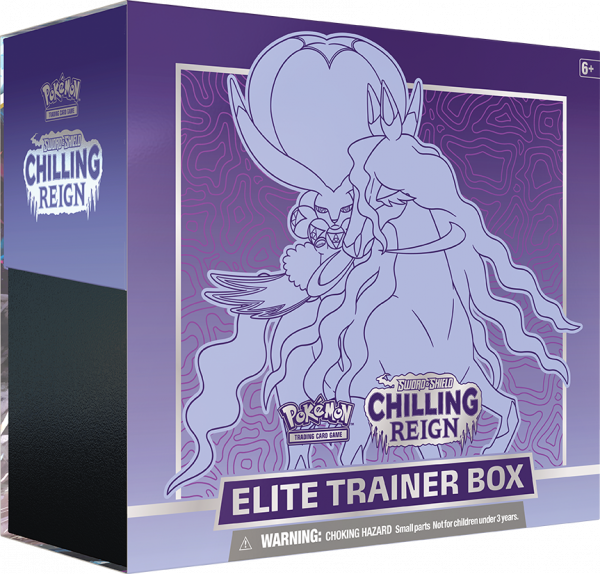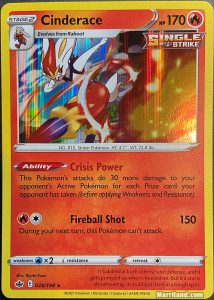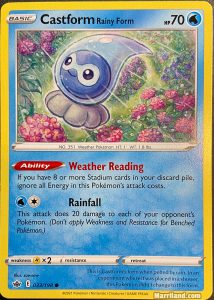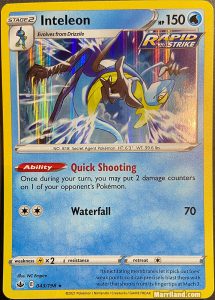Today marks the official release date of the Pokémon TCG set Sword & Shield—Chilling Reign, an expansion set featuring over 230 cards and themed around the Crown Tundra from the Pokémon Sword & Shield Expansion Pass.

As such, cards from the set include both forms of Calyrex—Ice Rider V/VMAX and Shadow Rider V/VMAX—as well as the three Galarian Legendary Birds—Galarian Articuno V, Galarian Zapdos V, and Galarian Articuno V. There are, of course, plenty of other cards and many more Single Strike and Rapid Strike cards to continue those strategies that were introduced in the previous set, Sword & Shield—Battle Styles.
The Pokémon Company International was also generous enough to send Marriland some sealed Booster Boxes and Elite Trainer Boxes of the set for review and unboxing purposes, and you can find these videos further on in this post, along with an analysis on several of the notable cards in the set.
Some Cards From the Set
Here’s a look at a few high-resolution images of some of the cards from Chilling Reign:
Booster Packs
Below is a look at the Booster Packs from the set. Unlike most sets, this one actually has five different booster pack artwork instead of four.
Elite Trainer Boxes
Lastly, here’s a look at the two different Elite Trainer Boxes that are available for Chilling Reign. Their contents are the same, although imagery and coloring change depending on whether you get the Ice Rider version (more of a blue theme) or the Shadow Rider version (more of a purple theme).
Marriland’s Thoughts On Some Cards (Review/Analysis)
There are plenty of cards in the set, and although these opinions may not reflect the competitive metagame or the impact they’ll have, they at least give some insight into some cool strategies or combos that the new set introduces.
Beedrill (003)
Beedrill (003) is a very strong, very cheap Single Strike Pokémon that can put the opponent in a very scary predicament if they depend on Special Energy cards to power up or enhance their Pokémon.
Its first attack, Persist Sting, which costs just one Grass Energy, instantly knocks out the opponent’s Active Pokémon if it has any Special Energy cards on it. Seeing a Weedle on the field should scare the opponent if they use those Special Energy cards and they probably won’t attach them, but that can slow them down or potentially mess with their strategy, and if they do happen to have one attached—either due to necessity or not realizing a Beedrill is coming from your end—they’ll be punished by losing their Active Pokémon with a single Energy.
Beedrill’s Jet Spear isn’t too bad either, hitting for a respectable 110 damage for just one Grass Energy as well. You have to discard an Energy attached to it, so it’s not free, but that still hits hard and also has the potential to be powered up even further due to being Single Strike.
Cinderace (028)
Cinderace (028) is another strong Single Strike Pokémon that is also a Stage 2, but it can do incredible amounts of damage, especially later on in the game.
You could skip its Ability and just read its attack, Fireball Shot, and think it’s pretty good. For just one Fire Energy and one Colorless Energy, it hits for a solid 150 damage, but you can’t attack with Cinderace next turn (unless you can return it to your Bench and then switch it back in, of course).
With just a Retreat Cost of 1, it’s not hard to get it out of there on those odd turns.
However, its Ability, Crisis Power, ramps up Cinderace’s damage even further for every Prize card your opponent has taken. It does +30 damage for each Prize card they’ve drawn, so if they have just one Prize card left in a standard game, Fireball Shot is suddenly hitting for 300 damage for just two Energy.
You could also attach a Single Strike Scroll of Piercing onto it to give it the Bullet Breakthrough attack, hitting for 120 damage for 1 Fire and 2 Colorless, and ignoring Weakness, Resistance, or any other effects on the opponent’s Active Pokémon. This damage increases with every Prize card the opponent has drawn, too, so after two Prize cards, this Cinderace is now hitting with an unstoppable 180 damage for three Energy and it can do an extra 30 in a pinch if you go back to Fireball Shot.
Castform
There are four Castform in the set and they each have the Ability Weather Reading, which makes all of their attacks FREE as long as you have 8 or more Stadium cards in your discard pile.
This isn’t the easiest thing to do, but if you build a deck around that and play enough cards to discard those cards from your hand, all four of the Castform have really nice attacks that can be used for free. They also all have 0 Retreat Cost, so they can retreat for free whenever they want.
Although all of them are good in their own ways, Castform Rainy Form’s Rainfall is nice to use even before you’ve gotten all 8 Stadium cards discarded, as it just costs 1 Water and 1 Colorless Energy and does 20 damage to all of your opponent’s Pokémon, even Benched Pokémon. This can be great to use while focusing on getting Stadium cards in your discard pile and then hitting with the stronger attacks of the other Castform forms against already weakened targets.
Unfortunately, a major downside is these Castform all have only 70 HP, so they are quite easy to knock out.
Inteleon (043)
Inteleon (043) is there mostly for its incredibly useful Ability, Quick Shooting, which allows you to place 2 damage counters on any of your opponent’s Pokémon each turn. This can serve as an immediate +20 damage to anything you’re attacking, or can let you target foes on the Bench to soften them up.
You can also use any number of these each turn, so if you have two Inteleon out with this Ability, you can use each of them. Several Inteleon cards (including the Pokémon V and VMAX cards, which don’t need to be evolved and aren’t competing for the evolution lines) do damage to the opponent’s Bench anyway, so the ability to add to that is great.
Its attack, Waterfall, is fairly lackluster by itself, although it will at least work in a pinch if you need to do some extra damage, plus it only takes Colorless Energy, so you could even slip this Inteleon into a non-Water deck if you really wanted extra damage to the opponent’s Bench.
Oh yeah, this Inteleon is also a Rapid Strike card, so it will benefit from several useful effects from other cards.
Flaaffy (048)

One of my favorite cards from the set, Flaaffy (048) isn’t particularly noteworthy or good in decks—though there is an upcoming Flaaffy card that will be incredible. Why is it on this list, then?
It’s just so darn cute! Look at that happy Flaaffy!
The art in the set is really nice, and sometimes its good to just take the time to smell the roses, or Roselia, or… well, yeah, let’s just say admire the art instead. It’s nice to do that and Chilling Reign has some very nice art in it, but this Flaaffy in particular is a delight.
Zeraora V (053)
Zeraora V (053) is all about teamwork and striking with a one-two attack, doing an absolutely insane amount of damage if one of your other Rapid Strike Pokémon attacked last turn.
Cross Fist‘s 100 damage for 1 Lightning Energy and 2 Colorless Energy is nice, but it does 160 damage to one of the opponent’s Benched Pokémon if any of your other Rapid Strike Pokémon attacked. Yes, 160 damage. You can easily pick up a lot of prize cards this way, and remember, the other Rapid Strike Pokémon doesn’t even need to have done damage; any attack will do.
Ideally, you’ll want to have a way to switch between Zeraora V and any of your other Rapid Strike Pokémon. A Pokémon Tool like Air Balloon on Zeraora V gives it the ability to retreat for free, or Stadium like Tower of Waters will also allow Zeraora V to retreat for free while it’s out as well, although it’s much easier for an opponent to discard that from play by playing their own Stadium.
It may be a bit difficult to get out, being a Stage 2 Pokémon, but the Luxray from Battle Styles—a fellow Rapid Strike Pokémon—works very well with Zeraora V if you can get it out. Its Electrostep does 40 damage to 1 of your opponent’s Pokémon and then you also switch Luxray out right away with one of your Benched Pokémon. You can hit something for 40, switch Luxray to something with free retreat (to keep your Luxray and Zeraora V safe), then just retreat it for Zeraora and attack. Luxray’s second attack also hits extremely hard, too.
Another potentially good card to use with Zeraora V is the new Passimian, to boost the damage it does with Cross Fist to an opponent’s Benched Pokémon V or GX to 190 instead. (It also powers up Luxray’s Electrostep, too.)
Passimian (088)
Passimian is a decent support Pokémon that helps improve the damage done by your Rapid Strike Pokémon’s Bench-damaging attacks, although only against Benched Pokémon V and Pokémon-GX.
As long as you have it in play, its Throwing Coach Ability powers up those attacks by 30 damage, which can be very nice. This works well with its own attack, Fling, which does 20 damage to 1 of your opponent’s Pokémon.
Keep in mind that you can’t use more than one Throwing Coach Ability at a time, but you can maximize the damage by hitting multiple Benched Pokémon V or Pokémon-GX with a single attack. The Rapid Strike Scroll of Swirls from Battle Styles gives any of your Rapid Strike Pokémon an attack that does 30 damage to each of your opponent’s Pokémon, so Passimian will power that up and hit any of their Benched Pokémon V or Pokémon-GX for 60 instead while still shredding the other Pokémon for a solid 30 damage. This can quickly accumulate a lot of damage and overwhelm your opponent’s ability to keep it under control, especially if they depend on Pokémon V, VMAX, or GX for their strategies.
Galarian Slowking V (099)
This rather silly looking Pokémon can apply a lot of pressure to your opponent with its second attack, Word of Ruin, which straight up knocks out the opponent’s Active Pokémon at the end of their next turn.
Now, mind you, this effect won’t happen if the opponent switches their Active Pokémon out via an effect or retreating, or if they evolve their Active Pokémon, but if they don’t do either of these things and attack Galarian Slowking V, they’ll be knocked out right afterwards.
It costs only two Energy—1 Dark, 1 Colorless—to use Word of Ruin, so it’s easy to swarm a bunch of Galarian Slowking V and keep using that attack over and over.
There are a few cards to help Galarian Slowking V survive longer while putting that pressure on your opponent. Galarian Chestplate is a new Pokémon Tool that can reduces incoming damage from attacks by 30 damage, so long as the Pokémon it’s attached to has Galarian in its name, which Galarian Slowking V does. Since it’s far riskier for your opponent to be attacking with their heavy hitters or Pokémon V or VMAX (unless they’re carefully switching out beforehand), this can ward off a lot of weaker damage from non-V or VMAX Pokémon.
Rugged Helmet is another new Pokémon Tool that works well with Galarian Slowking V. While attached, if it gets damaged from an attack, you put an Energy card on the attacking Pokémon back to their hand. It’s a double-edged sword, because it gives the opponent some of their resources (Energy) back if they call Galarian Slowking V’s bluff and attack anyway, since they’ll get one of their Energy cards back into their hand before being knocked out; on the other hand, this will enforce a constant drain on the opponent’s resources if they’re doing the wiser strategy of retreating/switching their Pokémon after getting hit with Word of Ruin, since they won’t be able to build up a good stockpile of Energy on their Pokémon.
Lastly, while it is a bit odd of a choice, the new Abomasnow has an Ability that gives any of your Single Strike Pokémon +50 HP. This gives Galarian Slowking V an incredible 270 HP and will just make it very hard for your opponent to take down over time and give you a chance to get more of them into play to keep spamming the Word of Ruin. It can be combined with the Galarian Chestplate to make it even tougher to get through.
Cresselia (064)
This is one of those cards that, at first glance, seemed like it was a lot of hassle, but it actually has a lot of potential to do a lot of damage right from the get-go and also benefits heavily from going second at the start of the game.
Its first attack, Crescent Glow, searches your deck for a Psychic Energy and attaches it to 1 of your Pokémon. Nice. However, if you go second and it’s your first turn, this allows you to search for three Psychic Energy cards instead.
That gives you such a huge advantage once you get to your second turn, as you’ve now powered up one of your Benched Pokémon (it’s usually not a good idea to target Cresselia with the first attack), and you can attach one more Psychic Energy from your hand to spam its second attack, Photon Laser, which does 90 more damage if you have at least 5 Energy in play.
Assuming you go second and are able to attach two Psychic Energy from your hand in your first two turns, which isn’t too unreasonable, you’ll be hitting with a 120 damage Photon Laser on turn 2 while you power up everything else on your Bench until Cresselia eventually faints, in which case you can either send out another one or send out your heavy hitter.
This combos very well with the Shadow Rider Calyrex VMAX shown earlier, which has the Max Geist attack, hitting for 30 more damage for each Psychic Energy attached to all of your Pokémon. Its Ability also allows you to attach Psychic Energy from your hand to power this up, but the point is that Cresselia is a great way to get started by dumping a bunch of Psychic Energy early on and applying a threatening 120 damage of pressure each turn while you set up.
Even if you don’t start with Cresselia, the ability to hit for 120 damage for just 2 Psychic Energy is very nice—so long as you have 5 total Energy in play, which really isn’t that high of a requirement. You can have it pick up some Prize cards in the mid-game while risking only one Prize card on it yourself.
Blissey V (119)

A very nice, versatile card, Blissey V (119) has a ton of HP for a non-VMAX—a stellar 250 HP on a basic Pokémon.
Its Ability, Natural Cure, is nothing to write home about and doesn’t really help the rest of your field, but it does allow Blissey V to almost entirely ignore Special Conditions so long as you feed it Energy cards from your hand.
Blissey V’s real strength lies in its Blissful Blast attack, which costs just a mere 1 Colorless Energy—in other words, one of any type of Energy, so it can fit in any type of deck with ease—and does a big ol’ 10 damage. 10 damage plus 30 more damage for each Energy attached to Blissey. Nice! So it’s a guaranteed 1-for-40.
“But wait, there’s more!” Yes indeed there is, because if you do any damage with this attack (in other words, as long as it’s not blocked or prevented), you can attach up to 3 Energy cards from your discard pile to Blissey V.
Now, unfortunately this effect occurs after doing damage, but at least your next attack will do up to 90 more damage, plus it can keep stacking and stacking, so long as you have the Energy in your discard pile. The later you are into the game, the more likely you are to have Energy there, and this can even get Special Energy cards back.
Mid-game, you give it one Energy, let it get back a bunch of Energy while doing good damage, and you use your standard Energy attachments to power up your Benched Pokémon.
If you have a way to move those Energy cards around or if you have any effects that do more damage for each Energy you have in play—for example, Shadow Rider Calyrex VMAX or Cresselia—you just need a way to switch Blissey out from the Active spot and you’re good. It has a rather massive 4 retreat cost, so retreating it is costly, although thankfully it should have that much Energy after one use of its attack, so it’s actually not as bad as it seems if you really need to get it out of there in a hurry.
Melony

Energy acceleration is always a useful mechanic, helping you get around the usual limitation of one Energy card per turn, and Melony is a helpful Supporter card to grant Energy acceleration to a group of Pokémon that often get left out: Pokémon V!
When played, she allows you to attach a Water Energy card from your discard pile to one of your Pokémon V and, on top of that, you also get to draw 3 cards as long as you’re able to attach that Energy. That limitation only really hurts if you draw Melony early in the game, before you have any Water Energy in your discard pile; other than that, it’s Energy acceleration and a decent card draw all in one.
Now, even though Melony only allows you to get Water Energy from your discard pile, it doesn’t have to be attached to a Water Pokémon; it can be attached to any of your Pokémon V. This can be helpful to power up Pokémon V that use Colorless Energy, although it’s still for the best that you focus on primarily Water Pokémon in your decks with Melony; just know that it can help accelerate your auxiliary Pokémon as well if you’re running different types.
The past few cards had good synergy with Shadow Rider Calyrex VMAX, but Melony is particularly good with Calyrex’s other form, Ice Rider Calyrex V as well as Ice Rider Calyrex VMAX.
Both of these cards have a rather expensive second attack that requires you—or, in the case of the VMAX, encourages you—to discard 2 Energy attached to it. These attacks do 200 and 250 damage respectively, which is certainly a lot of damage, but it gets costly keeping up with the keeping Calyrex fueled with Energy.
That’s where Melony comes into play: as long as you can attach a Water Energy from your hand, you can get one from your discard pile back onto Ice Rider Calyrex V or VMAX and keep the damage train chugging along.
Of course, you don’t need to use it solely for Energy recovery for attacks like Calyrex’s—it’s great for just powering up your other Water-type Pokémon V a turn quicker while still drawing cards for your turn.
Path to the Peak
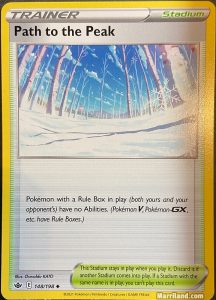
Lastly is the new Stadium card, Path to the Peak, which has the potential to disrupt a lot of strategies.
While it is in play, any Pokémon with a Rule Box (such as Pokémon V, Pokémon-GX, etc.) have no Abilities.
As there are a lot of very helpful Pokémon V out there that depend on their Abilities, having Path to the Peak in play to shut them down can be very disruptive.
It doesn’t remove the Abilities of ordinary Pokémon, though, so this is best played in a deck that uses either just ordinary Pokémon or only uses Pokémon V that don’t depend on their Abilities to get the job done, such as damage dealers.
Again, this one is far more situational, and it’s important for you to be aware of it whether you intend to play it or not, as Abilities are generally a very strong element of the Pokémon TCG and, whenever they are shut off, it can cause major disruptions to certain strategies.
If you depend on Pokémon V or Pokémon-GX Abilities for your deck, you’ll definitely need to consider having a way to counter Path to the Peak—thankfully, simply playing a Stadium card of your own will get rid of it and give you the rest of the turn to use your Abilities even if your opponent has another in their hand ready to go.

